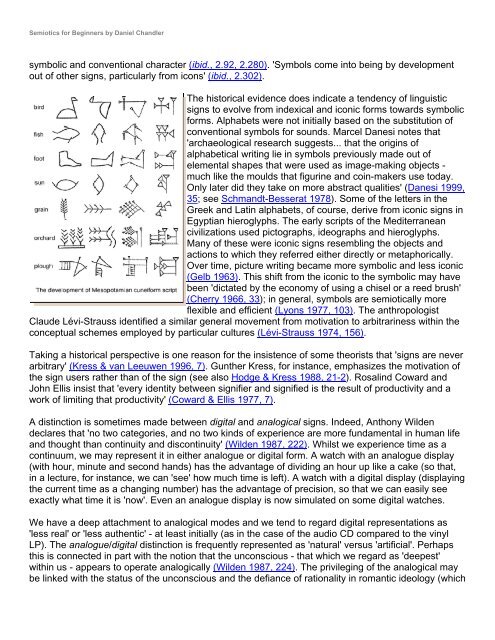Semiotics for Beginners by Daniel Chandler
Semiotics for Beginners by Daniel Chandler
Semiotics for Beginners by Daniel Chandler
You also want an ePaper? Increase the reach of your titles
YUMPU automatically turns print PDFs into web optimized ePapers that Google loves.
<strong>Semiotics</strong> <strong>for</strong> <strong>Beginners</strong> <strong>by</strong> <strong>Daniel</strong> <strong>Chandler</strong><br />
symbolic and conventional character (ibid., 2.92, 2.280). 'Symbols come into being <strong>by</strong> development<br />
out of other signs, particularly from icons' (ibid., 2.302).<br />
The historical evidence does indicate a tendency of linguistic<br />
signs to evolve from indexical and iconic <strong>for</strong>ms towards symbolic<br />
<strong>for</strong>ms. Alphabets were not initially based on the substitution of<br />
conventional symbols <strong>for</strong> sounds. Marcel Danesi notes that<br />
'archaeological research suggests... that the origins of<br />
alphabetical writing lie in symbols previously made out of<br />
elemental shapes that were used as image-making objects -<br />
much like the moulds that figurine and coin-makers use today.<br />
Only later did they take on more abstract qualities' (Danesi 1999,<br />
35; see Schmandt-Besserat 1978). Some of the letters in the<br />
Greek and Latin alphabets, of course, derive from iconic signs in<br />
Egyptian hieroglyphs. The early scripts of the Mediterranean<br />
civilizations used pictographs, ideographs and hieroglyphs.<br />
Many of these were iconic signs resembling the objects and<br />
actions to which they referred either directly or metaphorically.<br />
Over time, picture writing became more symbolic and less iconic<br />
(Gelb 1963). This shift from the iconic to the symbolic may have<br />
been 'dictated <strong>by</strong> the economy of using a chisel or a reed brush'<br />
(Cherry 1966, 33); in general, symbols are semiotically more<br />
flexible and efficient (Lyons 1977, 103). The anthropologist<br />
Claude Lévi-Strauss identified a similar general movement from motivation to arbitrariness within the<br />
conceptual schemes employed <strong>by</strong> particular cultures (Lévi-Strauss 1974, 156).<br />
Taking a historical perspective is one reason <strong>for</strong> the insistence of some theorists that 'signs are never<br />
arbitrary' (Kress & van Leeuwen 1996, 7). Gunther Kress, <strong>for</strong> instance, emphasizes the motivation of<br />
the sign users rather than of the sign (see also Hodge & Kress 1988, 21-2). Rosalind Coward and<br />
John Ellis insist that 'every identity between signifier and signified is the result of productivity and a<br />
work of limiting that productivity' (Coward & Ellis 1977, 7).<br />
A distinction is sometimes made between digital and analogical signs. Indeed, Anthony Wilden<br />
declares that 'no two categories, and no two kinds of experience are more fundamental in human life<br />
and thought than continuity and discontinuity' (Wilden 1987, 222). Whilst we experience time as a<br />
continuum, we may represent it in either analogue or digital <strong>for</strong>m. A watch with an analogue display<br />
(with hour, minute and second hands) has the advantage of dividing an hour up like a cake (so that,<br />
in a lecture, <strong>for</strong> instance, we can 'see' how much time is left). A watch with a digital display (displaying<br />
the current time as a changing number) has the advantage of precision, so that we can easily see<br />
exactly what time it is 'now'. Even an analogue display is now simulated on some digital watches.<br />
We have a deep attachment to analogical modes and we tend to regard digital representations as<br />
'less real' or 'less authentic' - at least initially (as in the case of the audio CD compared to the vinyl<br />
LP). The analogue/digital distinction is frequently represented as 'natural' versus 'artificial'. Perhaps<br />
this is connected in part with the notion that the unconscious - that which we regard as 'deepest'<br />
within us - appears to operate analogically (Wilden 1987, 224). The privileging of the analogical may<br />
be linked with the status of the unconscious and the defiance of rationality in romantic ideology (which




